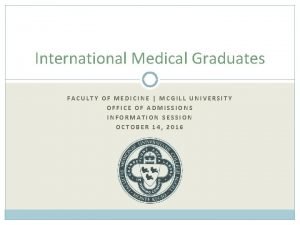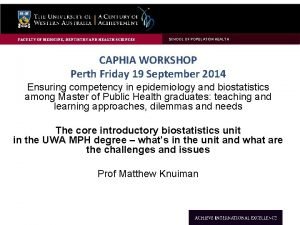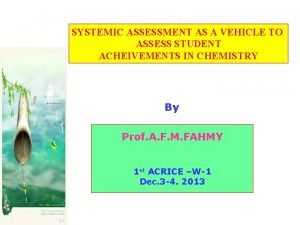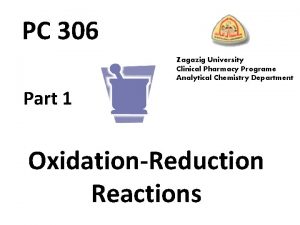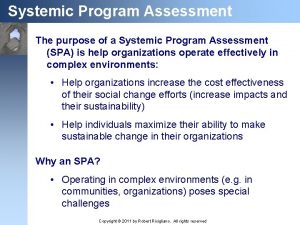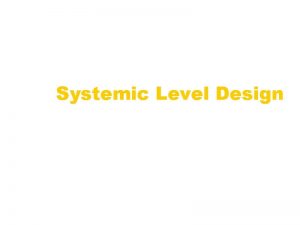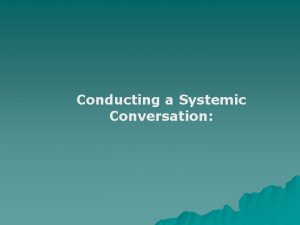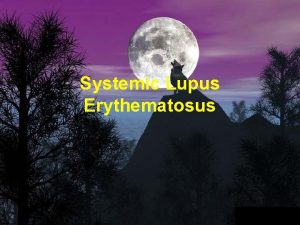SYSTEMIC ASSESSMENT Workshop Faculty of Medicine Zagazig University


![V-Systemic Matching Questions [SMQ, s] -Measure the student's ability to find the relationship between V-Systemic Matching Questions [SMQ, s] -Measure the student's ability to find the relationship between](https://slidetodoc.com/presentation_image_h2/8587414abc197e5927ab4d68fab84923/image-3.jpg)





![VI-Systemic Sequencing Questions: [SSQ, s] -SSQ, s require the student to position text or VI-Systemic Sequencing Questions: [SSQ, s] -SSQ, s require the student to position text or](https://slidetodoc.com/presentation_image_h2/8587414abc197e5927ab4d68fab84923/image-9.jpg)

![A) Example 1 : [Math. ]: Put the following numbers in the correct sequence A) Example 1 : [Math. ]: Put the following numbers in the correct sequence](https://slidetodoc.com/presentation_image_h2/8587414abc197e5927ab4d68fab84923/image-11.jpg)
![Example 2 : [Chem. ]: Put the iron and its compounds in the right Example 2 : [Chem. ]: Put the iron and its compounds in the right](https://slidetodoc.com/presentation_image_h2/8587414abc197e5927ab4d68fab84923/image-12.jpg)



![Example-1 : [Math. ]: Build a systemic diagram shows the correct numerical relations between Example-1 : [Math. ]: Build a systemic diagram shows the correct numerical relations between](https://slidetodoc.com/presentation_image_h2/8587414abc197e5927ab4d68fab84923/image-16.jpg)
![Example-2 : [Chem. ]: Build a systemic diagram Shows the correct chemical relations between; Example-2 : [Chem. ]: Build a systemic diagram Shows the correct chemical relations between;](https://slidetodoc.com/presentation_image_h2/8587414abc197e5927ab4d68fab84923/image-17.jpg)


![0 Example- : [Math. ]: Analyze the following numerical systemic into mathematical relations: 100 0 Example- : [Math. ]: Analyze the following numerical systemic into mathematical relations: 100](https://slidetodoc.com/presentation_image_h2/8587414abc197e5927ab4d68fab84923/image-20.jpg)


![Example : [Chem. ]: Complete the following systemic diagram by using the Following compounds Example : [Chem. ]: Complete the following systemic diagram by using the Following compounds](https://slidetodoc.com/presentation_image_h2/8587414abc197e5927ab4d68fab84923/image-23.jpg)



- Slides: 26

SYSTEMIC ASSESSMENT Workshop Faculty of Medicine Zagazig University PART-II Prof. A. F. M. FAHMY January 1020

SYSTEMIC ASSESSMENT SYSTEMIC LEARNING OUTCOMES
![VSystemic Matching Questions SMQ s Measure the students ability to find the relationship between V-Systemic Matching Questions [SMQ, s] -Measure the student's ability to find the relationship between](https://slidetodoc.com/presentation_image_h2/8587414abc197e5927ab4d68fab84923/image-3.jpg)
V-Systemic Matching Questions [SMQ, s] -Measure the student's ability to find the relationship between a set of similar items, each of which has two components, and their relation ships, and arrange them in a given systemic.

Disadvantage: - Do not allow instructors to measure students' writing skills. - Advantages: - Reduces the effects of guessing - Highly reliable exam scores. - Short reading and response time, allowing more content to be included in a given set of SMQ, s.

Guide lines for Writing SMQ, s. 1 -The items in the left (Column A) are usually called premises and assigned numbers (1, 2, 3, etc. ). 2 -The items in the right (Column B) are called responses and designated by capital letters (A, B, C etc). .

3 -The arrangement of premises , and responses are in a given systemic diagram (Column C, in the middle ) 4 - All of the premises and responses for a matching item should appear on the same page with the given systemic diagram.

IDEA: Choose concepts from column (A) & Relations From column (B) to build the correct systemic in column (C): A X Y Z E E F G C B . A B C D F , ILO: Synthesis

Example- (Chem): Choose Compounds from column (A) & Reaction Conditions from column (B) to build the correct systemic in column (C): . ,
![VISystemic Sequencing Questions SSQ s SSQ s require the student to position text or VI-Systemic Sequencing Questions: [SSQ, s] -SSQ, s require the student to position text or](https://slidetodoc.com/presentation_image_h2/8587414abc197e5927ab4d68fab84923/image-9.jpg)
VI-Systemic Sequencing Questions: [SSQ, s] -SSQ, s require the student to position text or formula, or events, or numbers in a given sequence of a systemic diagram. - To reduce guessing use large size systemics[pentagonal, hexagonal, . . ]. -

Disadvantage - Do not allow instructors to measure The students' writing skills. Advantages - Reduces the effects of guessing. - Highly reliable exam scores.
![A Example 1 Math Put the following numbers in the correct sequence A) Example 1 : [Math. ]: Put the following numbers in the correct sequence](https://slidetodoc.com/presentation_image_h2/8587414abc197e5927ab4d68fab84923/image-11.jpg)
A) Example 1 : [Math. ]: Put the following numbers in the correct sequence in the following systemic diagram: 30, 60, 120, 150 -60 --30 ( ) x 5 120 -60 60 -30 150 -30 x 5 30 ( ) ILO: Synthesis
![Example 2 Chem Put the iron and its compounds in the right Example 2 : [Chem. ]: Put the iron and its compounds in the right](https://slidetodoc.com/presentation_image_h2/8587414abc197e5927ab4d68fab84923/image-12.jpg)
Example 2 : [Chem. ]: Put the iron and its compounds in the right places in the following systemic diagram: Fe, Fe. CI 2, Fe. CI 3, Fe 2(SO 4)3, HCl gas Mg Air/ heat ( ) Conc. H 2 SO 4 Fe A) HCl gas Mg Fe. Cl 2 Air/ heat ILO: Synthesis Fe 2( SO 4)3 Conc. H 2 SO 4 Fe. Cl 3

VII-Synthesize Systemic relations between Items, Requires the Student to Position items [concepts , or formulas, , or events, or issues , or numbers and their relations] in a systemic diagram

Disadvantage - Do not allow instructors to measure The students' writing skills. Advantages: - Can measure various kinds of knowledge, including students' ability to correlate between concepts, formulas, numbers, or events.

- Can assess the students higher-order thinking skills. - Reduces the effects of guessing. - Highly reliable Questions scores.
![Example1 Math Build a systemic diagram shows the correct numerical relations between Example-1 : [Math. ]: Build a systemic diagram shows the correct numerical relations between](https://slidetodoc.com/presentation_image_h2/8587414abc197e5927ab4d68fab84923/image-16.jpg)
Example-1 : [Math. ]: Build a systemic diagram shows the correct numerical relations between the following numbers: 50, 75, 100, 150: ÷ 50 100 A-I) -50 150 75 A-II) ( 25+ X 2 +25 75 100 ÷ 2 150 2÷ +100 ) 50 ( )
![Example2 Chem Build a systemic diagram Shows the correct chemical relations between Example-2 : [Chem. ]: Build a systemic diagram Shows the correct chemical relations between;](https://slidetodoc.com/presentation_image_h2/8587414abc197e5927ab4d68fab84923/image-17.jpg)
Example-2 : [Chem. ]: Build a systemic diagram Shows the correct chemical relations between; Fe, Fe. CI 2, Fe. CI 3, Fe 2(SO 4)3: Fe A) HCl gas Mg Fe. Cl 2 Air/ heat Fe 2( SO 4)3 Conc. H 2 SO 4 Fe. Cl 3 ( )

VIII-Analyze Systemic to its Components Requires the Student to Analyze the given systemic diagram to its concepts or formulas, numbers, or events with their relations.

Disadvantage - Do not allow instructors to measure students writing skills. Advantages - Reduces the effects of guessing. - Highly reliable Questions scores. - Can assess higher-order thinking skills in which students are able to analyze, synthesize, evaluate.
![0 Example Math Analyze the following numerical systemic into mathematical relations 100 0 Example- : [Math. ]: Analyze the following numerical systemic into mathematical relations: 100](https://slidetodoc.com/presentation_image_h2/8587414abc197e5927ab4d68fab84923/image-20.jpg)
0 Example- : [Math. ]: Analyze the following numerical systemic into mathematical relations: 100 ÷ 2 50 -50 25+ 150 A) ( ) 75 X 2 50 + 25 = 7 5÷ 75 X 2 100 ÷ 2 = 150 = 50 ILO: Analysis

IX-Complete Systemics Requires the Student to Complete the Systemic Diagram with the given missing concepts or formulas, numbers or events and/or relations.

Advantages - Reduces the effects of guessing. - Highly reliable Questions scores. - Can assess higher-order thinking skills in which students are able to analyze, synthesize.
![Example Chem Complete the following systemic diagram by using the Following compounds Example : [Chem. ]: Complete the following systemic diagram by using the Following compounds](https://slidetodoc.com/presentation_image_h2/8587414abc197e5927ab4d68fab84923/image-23.jpg)
Example : [Chem. ]: Complete the following systemic diagram by using the Following compounds to give correct systemic: Fe. Cl 3, Fe 2(SO 4)3, Fe. Cl 2 Fe a) HCl gas Mg Air/ heat ( ) Conc. H 2 SO 4 Fe b) HCl gas Mg Fe. Cl 2 Air/ heat Fe 2( SO 4)3 Conc. H 2 SO 4 Fe. Cl 3 ( )

References: 1 -Fahmy, A. F. M. , Lagowski, J. J; Systemic Reform in Chemical Education , An International Perspective, J. Chem. Edu. , 2003, 80 (9), 1078. 2 -Fahmy, A. F. M. , Lagowski, J. J. , Using SATL Techniques to Assess Student Achievement, [18 th ICCE, Istanbul Turkey, 3 -8, August 2004]. 3 -ahmy, A. F. M. , Lagowski, J. J. , ” Systemic multiple choice questions (SMCQs) in Chemistry “[19 th ICCE, Seoul, South Korea, 12 -17 August 2006]. 4 -Fahmy, A. F. M. , Lagowski, J. J , “Systemic Problem solving [SPS] to Assess Student Achievement in Chemistry”[42 IUPAC Congress, 2 -7 Aug. 2009] 5 -Colleen M. and Bull, J. ; Workshop on designing objective test questions. CAA center (http: //caacenter. ac. uk/ university of luton, luton UK.

6 -Writing Multiple Choice Items which Require Comprehension by Russell A. Dewey, Ph. D http: //www. psychwww. com/selfquiz/aboutq. htm 7 -Mc. Millan, J. H. (2001). Classroom assessment Principles and practice for effective instruction. Boston: Allyn and Bacon. . 8 - http: //web. utk. edu/~mccay/apdm/match_b. htm

 Hubert kairuki memorial university faculty of medicine
Hubert kairuki memorial university faculty of medicine Semmelweis university faculty of medicine
Semmelweis university faculty of medicine King abdulaziz university faculty of medicine
King abdulaziz university faculty of medicine Territorial matrix vs interterritorial matrix
Territorial matrix vs interterritorial matrix Faculty of veterinary medicine cairo university logo
Faculty of veterinary medicine cairo university logo Hacettepe university faculty of medicine
Hacettepe university faculty of medicine Auricle of heart vs atrium
Auricle of heart vs atrium Semmelweis university faculty of medicine
Semmelweis university faculty of medicine Faculty of veterinary medicine cairo university
Faculty of veterinary medicine cairo university Cairo university faculty of veterinary medicine
Cairo university faculty of veterinary medicine Faculty of medicine nursing and health sciences
Faculty of medicine nursing and health sciences Department of medicine mcgill
Department of medicine mcgill Faculty of medicine dentistry and health sciences
Faculty of medicine dentistry and health sciences Coumadin clinic emory
Coumadin clinic emory Smcqs
Smcqs Herszon kherson maritime college of merchant marine fleet
Herszon kherson maritime college of merchant marine fleet Bridgeport engineering department
Bridgeport engineering department Bridgeport university computer science
Bridgeport university computer science Florida state university computer science faculty
Florida state university computer science faculty Faculty of business and economics mendel university in brno
Faculty of business and economics mendel university in brno Singularity executive program
Singularity executive program Masaryk university medical faculty
Masaryk university medical faculty Feup university of porto
Feup university of porto Charles university faculty of humanities
Charles university faculty of humanities Faculty of law of the university of zagreb
Faculty of law of the university of zagreb University of montenegro faculty of law
University of montenegro faculty of law University of kragujevac faculty of technical sciences
University of kragujevac faculty of technical sciences











